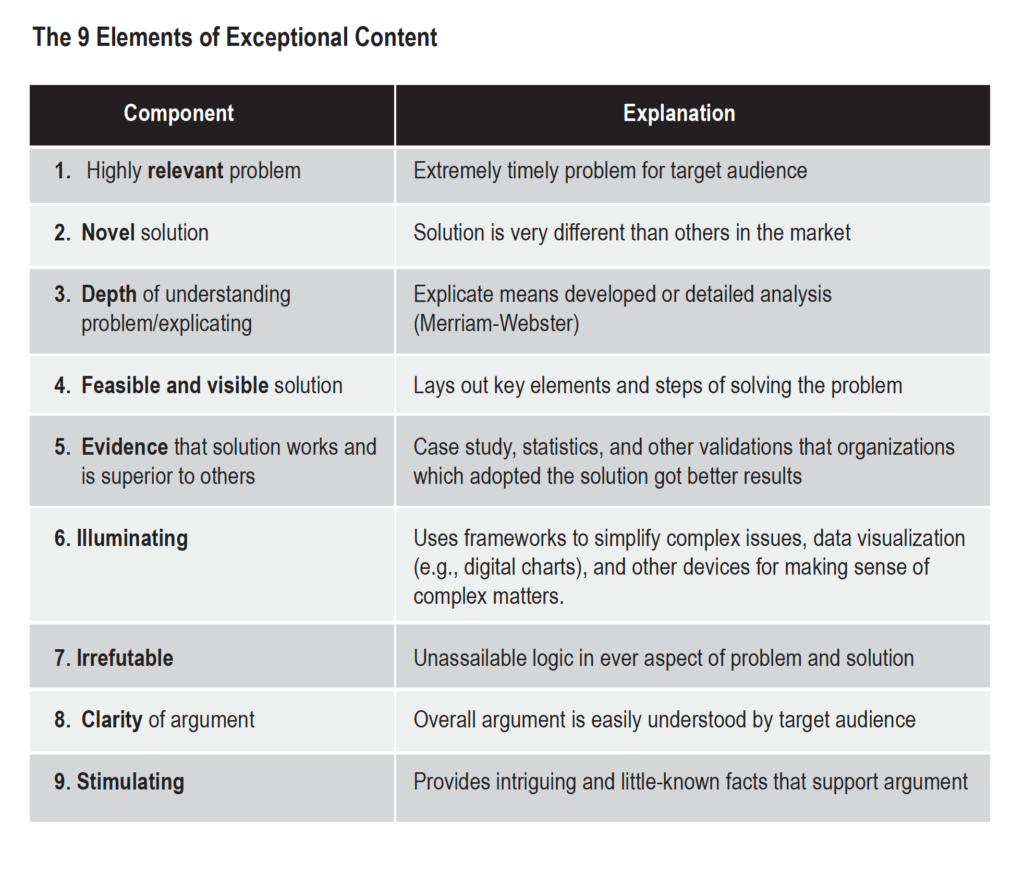Creating breakthrough ideas – Why “Content is King”
Persuasive and compelling content has a lion’s share in thought leadership. It can help you establish yourself as an expert in your field with a thorough understanding of your subject. Here, we take you through the elements of engaging content and the best approaches to create it using primary research.
Is your thought leadership content truly thought-provoking?
Despite their passion for thought leadership, that senior executives read only 31% of the information that hits their desk, of which, only 28% makes an impact on their decisions. When asked why it doesn’t attract their attention, their top complaints were:
- It’s too generic (63%)
- It’s devoid of creative insight or concepts (58%)
- Rather than addressing their needs, it promotes the company that created it (53%)
The nine characteristics of engaging content
To create appealing, high quality content that doesn’t need further help from experts to improve it, Bob Buday’s Thought Leadership Guide identifies 9 key characteristics and an explanation of why they are so importance. These are designed to help executives decide where they should focus their thought leadership, and how to ensure this which will stand up to audience scrutiny and deliver the greatest potential for attracting customers:

Five ways to build an effective thought leadership content
Being a thought leader isn’t easy. It requires you to be consistent in your content strategy efforts while guaranteeing that your audience communication does not go awry at any stage.
- Strategy: develop a content-centric approach
This requires a focus on creating strong content that is compelling and which the audience is more likely to engage with and, ideally, go on to share with a wider audience, and build engagement with your business. This means that executives need to recognize that this typically requires more time to be spent developing their ideas, research process, storytelling and amplification. Marketers also need to be rigorous in reviewing the performance of their thought leadership campaigns, and be prepared to make rapid improvements if cut-through isn’t being achieved. This is particularly important when the organization has made significant financial commitments. Another beneficiary of this approach is that the content can also be a driver for identifying new service approaches or offerings.
- Evidence: explore why you need it and how to get it
Thought leadership content is based on evidence, and content strategy is based on gaining recognition and driving revenue from your business’s expertise. It therefore needs to demonstrate your effective solutions to specific client issues.
This evidence can originate from:
- Successful client work, i.e. using a mix of interesting success stories and case studies
- Primary research on organizations that have employed a solution similar to the one you’re providing
- Illumination: Create enduring frameworks that simplify complexity
An idea that contains frameworks to reduce complex issues can be truly illuminating as they quickly clarify a complex idea, making it easy to grasp. This approach can be extended across thought leadership to build a consistent body of content.
- Rigor and Clarity: Make your argument airtight and understood
Your case studies must be rigorous enough to set out a major issue whilst promoting your company’s solution as the best. They also need to be clearly understood by your audience, employing concepts and terms they are familiar with, rather than unnecessary jargon.
- Deep Research: Develop your content with apt information
When you know what makes content appealing, it’s much easier to figure out what you’ll need to create great content. The first step is to decide whether you need primary research or if simply documenting your company’s direct experience will suffice, by analyzing the current condition of your firm’s expertise on a key client issue.
Compelling source of content: Primary Research
Rather than depending on pre-existing data samples, primary research helps to position a person or company as a knowledge leader and authority in a specific, critical topic, and is used to determine the concepts and ideas that underpin and add depth to a campaign.
The Importance of Primary Research for Thought Leadership explores in more detail where primary research adds value in thought leadership.
Author: Parija Kopergaonkar


